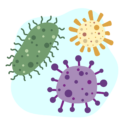In Nova Scotia, chlamydia is the most common sexually transmitted infection. That being said, if you are having sex, it is important to know all about the different types of STIs. Knowing what you are at risk of when you engage in different forms of sex and sexual acts can help inform the decisions you make around risk, STI testing, and other forms of prevention.
Every STI comes with its own symptoms, dangers, ways it can be transmitted, and treatment and testing options. Getting tested regularly is one of the most important things you can do to keep an eye on your own health and avoid passing STIs on to partners.
Check out our Check Me Out checklist to generate an STI testing checklist specific to you and your body!
And remember, STIs are great to avoid, but it’s okay if it happens – they are common and there are people out there happy to talk with you about your options without judgement! Just make sure you are taking the steps you can to treat your STI and avoid passing it on to other partners.
Click through this section to learn more about spotting STIs and about the different types of infections out there.
You can learn more about where HEAL NS got this information from at: NovaScotia, Canada,
*disclaimer: we do not necessarily endorse all of the information, content, or language used in these references.
Spotting STIs
Keeping an eye out for changes in your body that could indicate an STI is always a good thing to do, but it is important to know that many folks don’t show symptoms when they get an STI. A symptomless STI can be the most dangerous as someone who doesn’t know they have it is more likely to pass it on to other sexual partners. Additionally, not knowing you contracted an STI might mean you take longer to get treatment – which for some infections can cause more significant long term health impacts. This is why regular testing is so important; it lets you detect infections faster, get treated to cure or control, and be more confident you aren’t passing anything along to any sexual partners.
Having STI symptoms that clear up also doesn’t mean that the STI is gone. A common factor in many STIs is that they don’t go away on their own. If you have one you can pass it on and still end up with long-term health complications regardless of what symptoms you had and how long they were present.
That being said, there are a few symptoms it is a good idea to be aware of:
- Rashes, unusual colours, or bumps around your genitals or mouth
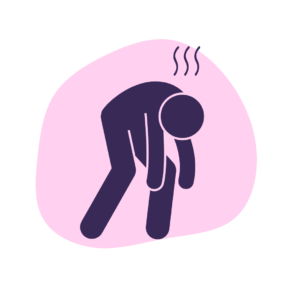
- Pain, discomfort, or non-menstrual bleeding during sex or urination
- Unusual smells, discharge, or fluids coming from or around your genitals
- Itchy, sore, or painful feelings on or around your genitals
- Sores, warts, or unusual skin growths around your mouth or genitals
If you notice any of these symptoms it is a good idea to get tested /examined. You can book an appointment with a family doctor, sexual health clinic or visit your local walk-in. If you let the people you are booking with know that you are showing symptoms, the presence of symptoms may change the priority you get depending on where you are booking. You can use the SUGAR Health Registry to find testing options near you.
Be mindful of these symptoms when having sex, and consider not having sex until you get these symptoms examined by a healthcare professional. If you are going to have sex you should let your partner know about the symptoms you have and allow them to make an informed decision. You can also consider using barrier protection (condoms, dental dams, etc) and/or other STI prevention methods, or have sex using other parts of your body. You could also use this time to explore other forms of intimacy with your partner, try having phone sex, masturbating next to each other, giving each other massages, or take time for non-sexual intimacy like cuddling, cooking dinner together, trying out a new hobby, or something else you’ll both enjoy.
You can learn more about where HEAL NS got this information from at: SUGAR Health, Mayo Clinic
*disclaimer: we do not necessarily endorse all of the information, content, or language used in these references.
Learn More About Specific STIs
What is HPV?
HPV (Human Papillomavirus) is a virus/viral infection that is commonly, but not exclusively, transmitted through sexual activities (including any form of penetration, oral sex, kissing in some cases, and more rarely, close skin to skin contact in other areas of the body).
 The HPV infection, if not fought off by the body’s natural defences can cause warts or lesions on the skin. HPV lesions can sometimes develop into cancer. There are many (over 200!) different strains of HPV, and having or having had one doesn’t stop you from getting another. A lesser known fact is that all warts are caused by HPV infections, and HPV strains that cause warts are rarely cancerous. HSV-6 and HSV-11 are the two most common strains of HPV, they sometimes cause warts and don’t commonly cause cancer. The more dangerous HPV strains can cause precancerous lesions which sometimes develop into cancer.
The HPV infection, if not fought off by the body’s natural defences can cause warts or lesions on the skin. HPV lesions can sometimes develop into cancer. There are many (over 200!) different strains of HPV, and having or having had one doesn’t stop you from getting another. A lesser known fact is that all warts are caused by HPV infections, and HPV strains that cause warts are rarely cancerous. HSV-6 and HSV-11 are the two most common strains of HPV, they sometimes cause warts and don’t commonly cause cancer. The more dangerous HPV strains can cause precancerous lesions which sometimes develop into cancer.
HPV is most likely to cause cancer in and around the cervix, so while HPV can affect anyone, it is extra important for folks’ who have a cervix or are having sex with anyone with a cervix to understand the increased risk of not taking protective measures.
 HPV is one of the most common STIs due to its ability to go unnoticed and be passed on. Around 85% of sexually active people will contract HPV in their lifetime. Luckily, most people who contract HPV will clear the viral infection in 1-2 years, but it can be life threatening for those who don’t, and they can pass it on to other folks during those years. Since, if you are sexually active, it’s more than likely you will contract HPV in your lifetime, it’s important to know how to keep an eye out for dangerous HPV and how to reduce transmission to and from yourself.
HPV is one of the most common STIs due to its ability to go unnoticed and be passed on. Around 85% of sexually active people will contract HPV in their lifetime. Luckily, most people who contract HPV will clear the viral infection in 1-2 years, but it can be life threatening for those who don’t, and they can pass it on to other folks during those years. Since, if you are sexually active, it’s more than likely you will contract HPV in your lifetime, it’s important to know how to keep an eye out for dangerous HPV and how to reduce transmission to and from yourself.
The Halifax Sexual Health Centre has created a fantastic resource on HPV that we recommend checking out to learn more.
How does transmission occur?
While the vast majority of cases of HPV are caused by infection through sexual contact/activity, there are still cases of non-sexual transmission. Doing things like wearing flip flops/bath shoes in public pools or showers can decrease your likelihood of catching common warts (caused by HPV). It can also, in rare cases, be passed down to a child during pregnancy, and so if you have HPV and are pregnant or trying to get pregnant you can talk to your doctor about the risks.
Sexual transmission of HPV happens through close skin to skin contact, most commonly either penetrative vaginal or anal sex, and oral sex.
How do I protect myself and my partner’s against it?
Since HPV is so common, and so commonly asymptomatic, it’s a good idea to think about HPV even in settings that seem low risk. Since you can have HPV and never develop symptoms, even if you are in a long-term monogamous relationship one partner may have HPV and be at risk of passing it on to their partner. Developing symptoms years into a sexually monogamous relationship also doesn’t mean that you were cheated on – symptoms can take years to develop, so you may have had it for longer than you realised, or just gotten it from your partner recently.
The more partners you have the more likely you are to be exposed to HPV. Which, as always, is not to say that you shouldn’t have all the sex that you want – just that it’s a good idea to consider you and your partners’ risk. Using condoms, and other forms of barrier protection are always a great way to reduce your risk of getting or passing along HPV. Washing your hands thoroughly after touching your partner’s genitals can also help prevent you from getting HPV.
 There are also now vaccines that protect folks against a few common strains of HPV – including some of the strains more likely to cause cancer. Gardasil 9 has the broadest protection, and is the vaccine most commonly given in Nova Scotia. It includes protection against HPV-6 and -11 (the two most common kinds) and HPV-16 and -18 (the two strains most likely to cause cervical cancer).
There are also now vaccines that protect folks against a few common strains of HPV – including some of the strains more likely to cause cancer. Gardasil 9 has the broadest protection, and is the vaccine most commonly given in Nova Scotia. It includes protection against HPV-6 and -11 (the two most common kinds) and HPV-16 and -18 (the two strains most likely to cause cervical cancer).
In Nova Scotia, the vaccine series is often started around the age of 11 as a part of the School Immunization Program. The Gardasil vaccine is currently approved for folks with penises aged 9-26 and folks with vaginas 9-45. Doctors can give the Gardasil shot to folks of any age. It is additionally recommended for folks who are HIV+ or who are ‘men who have sex with men’ and are aged 26 – 45.
It is offered at no cost to children in schools in Nova Scotia through the School Immunization Program (which began in 2007). If you are unsure whether or not you received the vaccine in a school in Nova Scotia you can contact your Public Health unit. It is also covered for men who have sex with men 19 – 46, people who are HIV+ and 19 – 46, and anyone under 19. For folks paying out of pocket it can cost over 600 dollars to get the full 3 dose series. Some private insurance plans may cover it.
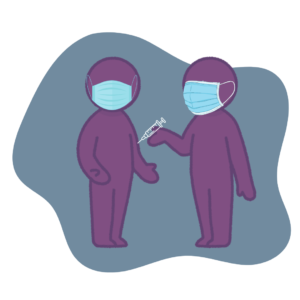 Gardasil is most effective when given before you become sexually active. If you are already sexually active, and/or have had an HPV exposure, this vaccine can still help reduce the risk of contracting other HPV strains and of developing certain HPV-related diseases. Having had a past HPV infection does not prevent you from getting future HPV infections, and those with an active HPV infection can still get other strains of HPV at the same time. The vaccine will still help protect you against other strains.
Gardasil is most effective when given before you become sexually active. If you are already sexually active, and/or have had an HPV exposure, this vaccine can still help reduce the risk of contracting other HPV strains and of developing certain HPV-related diseases. Having had a past HPV infection does not prevent you from getting future HPV infections, and those with an active HPV infection can still get other strains of HPV at the same time. The vaccine will still help protect you against other strains.
You can talk to your doctor, nurse, or local pharmacist about booking an HPV vaccine.
How do I know if I have it?
HPV is often asymptomatic which is why prevention methods are so important. Taking some time to explore the internet and photos of precancerous lesions and warts might be helpful, but a doctor will best be able to tell you if something on your skin is worrisome. If you notice any unusual bumps, lesions, growths, or sores, you should always get them checked out right away. Doctors may take biopsy’s (small samples of skin cells from the affected area) to look at more closely. There are tests that they can do to these cells to determine if they are infected with HPV or are cancerous.
If you have a cervix, getting routine cervical screening (or PAP tests) is important as you can’t otherwise see warts or lesions on or around your cervix.
What do I do if I get it?
Unfortunately, there is no cure for HPV. This is why preventative measures are so important.
The good news is that the vast majority of people will fight the virus on their own, but this can be less likely for folks that are immunocompromised, including folks living with HIV. If you find out you have HPV the best thing you can do is have regular check ups with your doctor to ensure your HPV doesn’t progress into something more dangerous.
If you have warts you can also have them removed at most doctor’s offices, walk-in clinics, or sexual health clinics, but it is important to know that just because the warts are gone it doesn’t mean that HPV isn’t still in your system.
How do I know if it developed into cancer?
The best thing you can do for your long term health with cancer is to catch it early, so if you have a growth or spot on your skin/mouth/genitals that you are at all worried about it is always a good idea to get it checked out by a doctor. You can go to a walk-in and ask for a referral, your family doctor, a sexual health clinic, or see a specialist. If they are worried they will likely take a small sample of the skin to test for cancer.
Check out the sections below to learn more about the common types of cancer caused by HPV.
You can learn more about where HEAL NS got this information from at: CANADA, HSHC, ClevelandClinic, Cancer.gov
*disclaimer: we do not necessarily endorse all of the information, content, or language used in these references.
Cervical Cancer
 Cervical Cancer is most commonly caused by HPV. It occurs when Dysplasia (the abnormal growth of cells) turns into cancerous growth inside of the cervix. The cervix sits at the base of the uterus, connecting it to the vagina. If cervical cancer is left untreated, the mass of cells (the tumour) can begin to grow at a more rapid rate, and eventually even spread to other parts of the body.
Cervical Cancer is most commonly caused by HPV. It occurs when Dysplasia (the abnormal growth of cells) turns into cancerous growth inside of the cervix. The cervix sits at the base of the uterus, connecting it to the vagina. If cervical cancer is left untreated, the mass of cells (the tumour) can begin to grow at a more rapid rate, and eventually even spread to other parts of the body.
If you are above the age of 25, and especially if you are sexually active, it is important to get regular cervical cancer screenings with a doctor. It’s a good idea to keep an eye out for the following symptoms that may indicate early stages of cervical cancer:
- Pain during penetrative sex
- Bleeding before or after sex
- Thin, watery, (sometimes bloody) discharge with a strong smell
- Pain urinating or during bowel movements
- Bleeding during urination or bowel movements
- Bleeding around your period or after menopause
- Swollen legs
- Persistent back ache
- Fatigue
* It’s important to note that all of these systems could be symptoms of something else – so don’t panic. If you are experiencing any of these talk to your doctor, look at booking an appointment through Maple Health, or go to a walk in to discuss your risk and determine next steps.
The prognosis of a cervical cancer diagnosis is greatly dependent on you and your body, as well as how quickly it is found and treated. The earlier you begin treatment, the greater your chances, which is why we recommend knowing what symptoms to look out for and getting regular cervical cancer screens.
In Nova Scotia, Pap tests / cervical screenings are covered by MSI through the Cervical Cancer Prevention Program. We would also like to note that the language used throughout this province is overwhelmingly gendered. You do not need to be a woman to have a cervix, (or have a cervix to be a woman), and cervical cancer screening is necessary for anyone with a cervix, especially those that are sexually active. You have a right to this care, regardless of your gender. Lots of healthcare providers in NS are gender-affirming, but unfortunately lots aren’t. You can check out this resource by the Community-Based Research Centre for tips on advocating for and taking care of yourself around healthcare appointments.
Folks who have had vaginoplasty do not need to be screened for cervical cancer as they do not have cervixes.
Folks who have had any sort of phalloplasty (creation of a penis) and vaginectomy where their vaginal opening was closed but have not had a hysterectomy are still at risk for cervical cancer however cannot get cervical screenings done since the cervix/uterus is not accessible. There are alternative methods for checking for cervical cancer including MRI, abdominal ultrasounds, serum biomarker testing, pelvic exams, and more. You can talk with a doctor to evaluate if any of these screens makes sense for you.
If you have a family doctor, they are a great person to ask about cervical screenings. You can also check out SUGAR Health to find out where to get a screening near you.
You can learn more about where we got this information from at: SUGAR Health, NS Health, Trans Wellness Initiative, Cancer.ca, Cleveland Clinic, NCBI
*disclaimer: we do not necessarily endorse all of the information, content, or language used in these references.
Vaginal Cancer
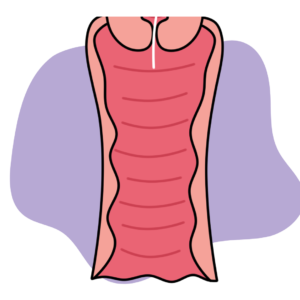 Most incidences of vaginal cancer are caused by HPV, however older folks and folks who smoke tobacco/cigarettes are at a greater risk of developing vaginal cancer. It is a very rare form of cancer that involves the growth of cancerous cells in the vagina, the canal between the vulva (the outer part of the reproductive system) and the cervix.
Most incidences of vaginal cancer are caused by HPV, however older folks and folks who smoke tobacco/cigarettes are at a greater risk of developing vaginal cancer. It is a very rare form of cancer that involves the growth of cancerous cells in the vagina, the canal between the vulva (the outer part of the reproductive system) and the cervix.
There are two main types of vaginal cancer:
- Squamous cell carcinoma. The vast majority of vaginal cancer cases are squamous cell carcinoma. Squamous cells are a thin flat cell that line your cervix, and this type of vaginal cancer often develops at the top of the vagina, close to where it connects to the cervix. This cancer often develops slowly, and can often be caught during a routine Pap test/pelvic exam.
- Adenocarcinoma. This form of cancer occurs in the cells that make up the glands of an organ. It is a less common type of vaginal cancer making up around only 10% of cases. It most commonly presents as clear cell adenocarcinoma; a type of cancer caused by exposure to the drug diethylstilbestrol (DES). This drug was used to prevent miscarriage in Canada and the US until 1971, meaning folks under the 50 are quite unlikely to have been exposed to DES.
Many of the signs and symptoms for vaginal cancer are the same as cervical cancer, however, in some cases you may also be able to feel the growth of a mass. Because vaginal cancer develops slowly many folks do not experience symptoms during early stages – which is why it’s so important to get routine Pap tests / cervical screenings.
It is also important to note that folks who have had hysterectomies / oophorectomy can still get vaginal cancer as the vagina is capped but largely still left un-altered.
If you have a family doctor, they are a great person to ask about Pap tests. You can check out SUGAR Health to find out where to get a Pap test and pelvic exam near you.
Vaginal cancer in vaginas created through vaginoplasty
Folks who have had vaginoplasty (surgically constructed vulvas and vaginas) the risk of cancer on their vulva or vagina is actually more similar to those with penises because the skin used to create the vulva/vagina is penile skin. This means that in this case vaginal or vulvar cancer functions and is treated as penile cancer. This is not because folks still have a penis, but because the skin cells are the same cells that created the penis prior to surgery.
Penile cancer is most commonly caused by HPV, but is less likely to occur than vulvar and vaginal cancer. Folks who have had vaginoplasty should still get regular exams.
Check out our section on Penile Cancer to learn more.
You can learn more about where HEAL NS got this information from at: SUGAR Health, Cleveland Clinic, Cancer, Medical News Today, Healthline
*disclaimer: we do not necessarily endorse all of the information, content, or language used in these references.
Vulvar Cancer
 The types of cancers described above can also occur in the vulva (the soft tissue around the vaginal opening, urethra (pee-hole), and clitoris. Similarly to the above cancers infection of certain HPV strains are a risk factor for developing skin cancer. Peopleabove the age of 50 are also more likely to develop cancer, and smoking can increase someone’s risk as well.
The types of cancers described above can also occur in the vulva (the soft tissue around the vaginal opening, urethra (pee-hole), and clitoris. Similarly to the above cancers infection of certain HPV strains are a risk factor for developing skin cancer. Peopleabove the age of 50 are also more likely to develop cancer, and smoking can increase someone’s risk as well.
Similarly to other types of cancers near the pelvis, routine pap tests and pelvic exams are good ways to catch it early – something which can really increase your chances of recovery. If you aren’t sure where to do this check out the Sugar Health Registry and Warmline. If you notice pain while urinating, itching or bleeding on your vulva, changes to the skin on the vulva (colour or thickening) the development of a new lump, sore, or wart, it is a good idea to go get it checked out at your doctor or local walk in clinic.
Similarly to vaginal cancer Squamous Cell Carcinoma is the most common and widespread form of cancer. Less commonly, folks can also develop Adenocarcinoma on their vulva. About 3% of vulvar cancer cases are a form of melanoma (the common skin cancer associated with sun exposure – that can in rare cases develop in places not commonly exposed to sun – like the vulva).
Vulvar cancer in vulvas created through vaginoplasty
Folks who have had vaginoplasty (surgically constructed vulvas and vaginas) the risk of cancer on their vulva or vagina is actually more similar to those with penises because the skin used to create the vulva/vagina is penile skin. This means that in this case vaginal or vulvar cancer functions and is treated as penile cancer. This is not because folks still have a penis, but because the skin cells are the same cells that created the penis prior to surgery.
Penile cancer is most commonly caused by HPV, but is less likely to occur than vulvar and vaginal cancer.
Check out our section on Penile Cancer to learn more.
You can learn more about where HEAL NS got this information from at: Cancer, Hopkins Medicine, Medical News Today
*disclaimer: we do not necessarily endorse all of the information, content, or language used in these references.
Penile Cancer
 While HPV is less likely to cause cancer in people with penis’ however HPV is still the most common cause of penile cancer when it does occur. The other risk factor for penile cancer is precancerous infections. These conditions are rarely dangerous unless left untreated. Another factor that can increase your risk of penile cancer is the build up of smegma (a substance made up of dead skin cells) under the foreskin. This build-up can create irritation and infection which can increase your likelihood of developing penile cancer. Regular cleaning under the foreskin can prevent this build-up.
While HPV is less likely to cause cancer in people with penis’ however HPV is still the most common cause of penile cancer when it does occur. The other risk factor for penile cancer is precancerous infections. These conditions are rarely dangerous unless left untreated. Another factor that can increase your risk of penile cancer is the build up of smegma (a substance made up of dead skin cells) under the foreskin. This build-up can create irritation and infection which can increase your likelihood of developing penile cancer. Regular cleaning under the foreskin can prevent this build-up.
If you were circumcised as a child, you have a lower risk of developing penile cancer. Recent research suggests that whether a penis is circumcised does not significantly alter rates of cancer in adults.
Penile cancer often can be noticed through a combination of the following symptoms:
- Growths, bumps, or lumps
- Rashes, redness, or irritation, in some cases sores
- Production of a smelly discharge
Right now, penile cancer is not common enough for screenings to be recommended for Nova Scotians, however, if you notice any of the above signs go get it checked out by your family doctor, sexual health clinic, or a walk-in clinic. If they see any signs for concern they will give you a referral to a urologist.
Penile cancer in folks who have had phalloplasty (surgery to create a penis) has been seen only a very small number of times, but with such little research on this, it is definitely still possible to develop a type of skin cancer on the penis. As always, it is a good idea to see a doctor if you notice anything unusual.
You can learn more about where HEAL NS got this information from at: Cancer.ca
*disclaimer: we do not necessarily endorse all of the information, content, or language used in these references.
Oropharyngeal Cancer
 Oropharyngeal cancer involves cancer of the squamous (skin) cells of the oropharynx. The oropharynx is made up of the back third of your tongue, tonsils, and soft palette, and the back walls of your throat – basically the tissue that makes up the back of your mouth and top of your throat. HPV infections (along with smoking) is one of the main triggers for this type of cancer.
Oropharyngeal cancer involves cancer of the squamous (skin) cells of the oropharynx. The oropharynx is made up of the back third of your tongue, tonsils, and soft palette, and the back walls of your throat – basically the tissue that makes up the back of your mouth and top of your throat. HPV infections (along with smoking) is one of the main triggers for this type of cancer.
While this is not one of the more common cancers caused by HPV, it is a piece of the risk folks can consider while performing oral sex. Oral sex performed on all genitals, as well as sex toys that have come into contact with another person’s fluids can pass on HPV. Barrier methods can be highly effective in reducing the chances of passing HPV through oral sex.
Oropharyngeal cancer can be asymptomatic in early stages. The following symptoms could point to cancer: ongoing sore throat or trouble swallowing, rapid weight loss, a lump at the back of the throat, ear pain, or blood coming up when coughing, or a spot (often white) at the back of the mouth or tongue. These symptoms don’t mean that you for sure have oropharyngeal cancer, but do mean it’s a good idea to see a doctor to get them checked out.
You can learn more about where HEAL NS got this information from at: Cancer.ca,
*disclaimer: we do not necessarily endorse all of the information, content, or language used in these references.
What is Hepatitis?
 Hepatitis is a medical word used to describe a liver that is inflamed. A number of things can negatively impact the liver, causing it to become inflamed and impacting its ability to function properly. Generally, Hepatitis is a condition that progresses slowly, but it can become acute and lead to life-threatening effects.
Hepatitis is a medical word used to describe a liver that is inflamed. A number of things can negatively impact the liver, causing it to become inflamed and impacting its ability to function properly. Generally, Hepatitis is a condition that progresses slowly, but it can become acute and lead to life-threatening effects.
Your liver filters out toxins in your body, and so can become inflamed by an overload of toxins from heavy alcohol or drug use (including prescribed medications). Some medical / health conditions can also cause or lead to hepatitis. The third cause of hepatitis is called viral hepatitis where a virus leads to liver inflammation. The three viruses most commonly known to cause Hepatitis are Hepatitis A (HAV, Hep A), Hepatitis B (HBV, Hep B), and Hepatitis C (HCV, Hep C). There is also a satellite virus called Hepatitis D that is associated with the Hepatitis B virus. This means that only people who have Hepatitis B are able to get Hepatitis D.
What is the difference between Hepatitis A, B, and C?
Hepatitis A, B, and C are in many ways vastly different viruses, they just all cause liver inflammation. Check out the chart below to see some of their key differences and similarities.
| HEPATITIS A | HEPATITIS B | HEPATITIS C | |
|---|---|---|---|
| How is it transmitted? | >HAV is spread by ingesting the virus. This means it is spread mostly by contamination of food products. It is resistant to heating and freezing and can survive for a while in food. | HBV is spread through infected blood entering the body of someone without HBV.
Similarly to HCV and HIV, this can include certain sexual acts, improper cleaning procedures during tattooing, skin piercings, or medical procedures, giving birth, or sharing drug equipment, especially needles. It also includes any other activities where someone’s blood (even in microscopic amounts) comes into contact with another person’s blood stream. HBV is not spread through saliva. |
HCV is spread through infected blood entering the body of someone without HCV.
Similarly to HBV and HIV, this can include certain sexual acts, improper cleaning procedures during tattooing, skin piercings, or medical procedures, giving birth, or sharing drug equipment, especially needles. It also includes any other activities where someone’s blood (even in microscopic amounts) comes into contact with another person’s blood stream. |
| What short term effects does it have on the body? | HAV usually becomes symptomatic between 2 to 4 weeks after getting the virus. These symptoms can include jaundice (yellowing of the skin and sometimes eyes), fever, stomach pain, nausea and dark urine. | HBV is often asymptomatic.
If it develops into acute Hepatitis this generally occurs between 8 weeks to 5 months after exposure. |
In about half of people, HCV is a short term illness that the body can fight off on its own. This has similar symptoms to HBV and HAV.
The other half of people develop long term HCV. |
| What long term effects does it have on the body? | HAV normally clears on its own after several weeks leaving no long term health impacts and future HAV immunity.
In rarer cases folks may develop HAV relapses, when this happens they often experience similar symptoms as their first instance of acute hepatitis, and again, it most often clears itself within a month. |
Often, people clear HBV on their own.
If they develop HBV they usually experience some combination of symptoms: jaundice (yellowing of the skin and sometimes eyes), fever, exhaustion and stomach pain, nausea and dark pee. In severe cases the is can lead to death. Some people who contract HBV will develop chronic or long-term HBV. This can go unnoticed and show no symptoms for over 15 years. Long-term HBV can lead to cirrhosis (scar tissue build up on the liver that can eventually lead to liver failure), or the development of liver cancer. Both of these conditions can be fatal. |
Long term HCV often shows no symptoms for a long time – this is part of the reason why testing for HCV is so important. Long-term (also called chronic) HCV can lead to long-term health conditions including life threatening cirrhosis (scar tissue build up on the liver that can eventually lead to liver failure), or the development of liver cancer. Both of these conditions can be fatal. |
| Is there a vaccine for it? | Yes.
In Nova Scotia, vaccines are covered by MSI for certain at risk groups and can be purchased by anyone else. It is encouraged for folks travelling to countries where HAV prevalence is high, and is not available for children under the age of 1. Learn more here. |
Yes.
The HBV vaccine is recommended for most children. Post-exposure Prophylaxis (PEP) is also available for newborns who’s birthing parent has HBV. A combination HBV/HAV vaccine is sold in Nova Scotia and encouraged for folks travelling to countries where HBV prevalence is high. There are also certain at risk populations who can get this combination vaccine covered by MSI. Learn more here. |
No. |
| Is there a cure for it? | There is no specific cure for HAV.
Most cases that result on their own, and for folks that end up leading to hospitalization treatment often includes managing pain and discomfort and providing fluids to avoid dehydration. |
While there is not a specific cure for HBV there are treatments.
Folks with acute HBV can be treated for pain and discomfort and given fluids to avoid dehydration. There are also medications for folks who develop chronic HBV that can slow down the development of cirrhosis and decrease the likelihood of developing liver cancer. |
There are a number of treatment options available in Nova Scotia for those who test positive for HCV, and this treatment can clear the vast majority of cases. |
| How common is it in Nova Scotia, Canada? | The incidence of HAV is very very low in Nova Scotia.
It has stayed below 1 out of 100,000 people since the year 2000. |
The incidence of HAV is very very low in Nova Scotia.
As of 2020 cases have decreased to about 0.5 cases per 100,000 people. |
HCV is the most common hepatitis virus in Nova Scotia.
Around 25 out of 100,000 (or, 1 out of 4000) people have HCV in this province. |
How can I prevent transmitting Hepatitis?
Since HBV and HCV are carried in the blood, preventing the transmission of these virus’ means avoiding situations where an HV+ person’s blood might enter someone without HV’s body or bloodstream.
 In Nova Scotia, there are vaccines protecting against both Hep A and Hep B (TWINRIX), and vaccines protecting against just Hep A or Hep B. Hep B vaccines are often given out to school age children in Nova Scotia (as of 1995). If you went to school in Nova Scotia you can contact your Public Health unit to see if you received the vaccine. If you did not receive the vaccine you can talk to your doctor about if it is right for you. It is only covered for certain at-risk populations.
In Nova Scotia, there are vaccines protecting against both Hep A and Hep B (TWINRIX), and vaccines protecting against just Hep A or Hep B. Hep B vaccines are often given out to school age children in Nova Scotia (as of 1995). If you went to school in Nova Scotia you can contact your Public Health unit to see if you received the vaccine. If you did not receive the vaccine you can talk to your doctor about if it is right for you. It is only covered for certain at-risk populations.
While very uncommon in Nova Scotia, HCV can be passed through re-using or improperly cleaning tattooing and piercing equipment or medical tools. If you are getting your body pierced or a tattoo by someone outside of a professional setting it is always a good idea to check in about how they are keeping you safe.
More commonly in Nova Scotia HCV is passed on through sharing drug use equipment or through barrier-free sex (sex without condoms or dental dams).
For sexually transmitted HCV most of the activities that are higher risk for passing on HIV (such as anal and vaginal sex) are also more likely to pass HCV since the mode of transmission is so similar. You can check out our section on HIV to learn more. Using preventative measures such as wearing a condom during sex, electing for lower risk sex acts (such as oral sex) with folks who haven’t tested recently for HCV (or whose status you are unsure about), and testing regularly are all great ways to lower your risk. If you have tested positive for HCV it is a good idea to refrain from sex acts that can pass HCV until you have completed treatment. This can be a time to explore other forms of intimacy in your relationships, or get to know your body better!
For HCV transmitted through drug-use, the single most important thing you can do to prevent transmission is not sharing drug-use equipment, especially equipment that comes into contact with your blood. Using new and clean equipment any time you use substances means that HCV has no mode of transmission from one person to another. If you do not have access to new drug use equipment we recommend looking for harm reduction sites near you.
Here is a short list of some of the harm reduction sites we know in Nova Scotia:
Halifax – The Mainline Needle Exchange
Halifax – Direction180
Truro – Northern Healthy Connections Society
Cape Breton – Ally Centre of Cape Breton
Mainline Needle Exchange also offers a program called the brown bag program where you can pick up drug use supplies at a long list of pharmacies around the province. Visit this link to learn more.
How do I know if I have/get Hepatitis C?
The only way to know for sure that you have HCV is to get tested. HCV testing involves going to a testing centre and getting a sample of your blood taken. Testing can be done at most places in the province that offer STI testing, including sexual health clinics, and hospitals.
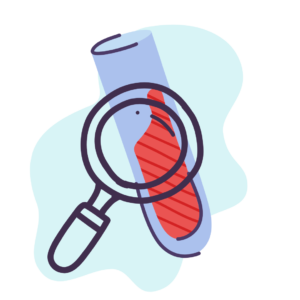 All blood samples in Nova Scotia are then sent to the Hepatitis C clinic at the QEII Hospital in Halifax. Generally, two types of tests are performed on blood samples; anti-HCV and HepC RNA tests. The anti-HCV tests look for antibodies, the defence your body creates against the virus, and HepC RNA tests look for a piece of genetic material that is created by the virus. In simpler terms, the anti-HCV test is looking to see if your body is responding to the presence of the virus, and the HepC RNA test is looking to see if it can find pieces of the virus itself in your body.
All blood samples in Nova Scotia are then sent to the Hepatitis C clinic at the QEII Hospital in Halifax. Generally, two types of tests are performed on blood samples; anti-HCV and HepC RNA tests. The anti-HCV tests look for antibodies, the defence your body creates against the virus, and HepC RNA tests look for a piece of genetic material that is created by the virus. In simpler terms, the anti-HCV test is looking to see if your body is responding to the presence of the virus, and the HepC RNA test is looking to see if it can find pieces of the virus itself in your body.
If the HepC RNA test comes back positive that means that you have an active Hepatitis C infection in your body. If the anti-HCV test comes back positive, but the HepC RNA test is negative, this most likely means you have had an infection in the past that has either been treated, or that your body fought off without you even realising you had it.
Aside from testing, it never hurts to keep an eye out for these symptoms listed in the chart under the ‘What is the difference between Hepatitis A, B, and C?’ section. That being said, not all cases of HCV show symptoms, and so it is best for your health and the health of your sexual partners to set up a regular testing schedule for yourself – especially if you are having barrier-free sex with multiple partners!
Check out our testing tool to generate a personalized list of tests to get and an idea of how often to get them!
Can Hepatitis C be treated?
Yes, it can!
 Hepatitis C treatment is available for anyone over the age of 3 in Canada, and can clear viral infections 95% of the time. HCV treatment usually involves a combination of medications called direct-acting antivirals (DAAs) that are taken for approx. 3 months.
Hepatitis C treatment is available for anyone over the age of 3 in Canada, and can clear viral infections 95% of the time. HCV treatment usually involves a combination of medications called direct-acting antivirals (DAAs) that are taken for approx. 3 months.
If you know that you have HepC is is best to talk to your family doctor, your local sexual health clinic, or go to your local walk-in to get started on treatment as soon as possible, When you get your tests results back you should be directed to treatment options near you, but if you weren’t don’t hesitate to reach out to us at HEAL NS.
When on treatment, it is a good idea to refrain from activities where you could pass HCV on to other folks.
If you want to learn more about HCV treatment you can look through this resource created by CATIE.
 In Nova Scotia, the vast majority of folks are covered through MSI and Provincial Pharmacare. However, the cost of treatment can cost between $60,000 and $120,000 for those who aren’t covered. Additionally, some private insurance plans cover HCV treatment.
In Nova Scotia, the vast majority of folks are covered through MSI and Provincial Pharmacare. However, the cost of treatment can cost between $60,000 and $120,000 for those who aren’t covered. Additionally, some private insurance plans cover HCV treatment.
You can learn more about where HEAL NS got this information from at: WHO, CDC, NovaScotia, WHO, CDC, SHNS, Mainline Needle Exchange, Direction 180, NHC Society, Ally Centre of Cape Breton, CATIE
*disclaimer: we do not necessarily endorse all of the information, content, or language used in these references.
 The most recent provincial statistics (2021) show that Chlamydia is one of the most common STIs in Nova Scotia. It has an incidence rate of 220.5 cases per 100,000 people. This means that for every 100 people living in Nova Scotia over 2 of them will have chlamydia.
The most recent provincial statistics (2021) show that Chlamydia is one of the most common STIs in Nova Scotia. It has an incidence rate of 220.5 cases per 100,000 people. This means that for every 100 people living in Nova Scotia over 2 of them will have chlamydia.
Like all STIs there are a number of things you can do to reduce your chances of getting or passing along chlamydia. Take a look through this section to learn more about chlamydia.
What is Chlamydia?
Chlamydia is an infection that is caused by a bacteria called Chlamydia trachomatis (C. trachomatis). It is passed from person to person primarily through sexual contact, and does not get passed through casual contact (holding hands, sharing a toilet seat, kissing etc.).
 There are a number of different strains of C. trachomatis, and they each have different risks associated with them, but these strains are generally separated into two categories: LGV and non-LGV genotypes. Chlamydia strains with the LGV genotype infect your body differently than the non-LGV types. They infect your lymph nodes, an important piece of your body’s defence against infections. This may sound like really technical language, but basically what it means is LGV types of chlamydia are more aggressive infections that can cause symptoms that reach your whole body (fever, pain, fatigue, etc.).
There are a number of different strains of C. trachomatis, and they each have different risks associated with them, but these strains are generally separated into two categories: LGV and non-LGV genotypes. Chlamydia strains with the LGV genotype infect your body differently than the non-LGV types. They infect your lymph nodes, an important piece of your body’s defence against infections. This may sound like really technical language, but basically what it means is LGV types of chlamydia are more aggressive infections that can cause symptoms that reach your whole body (fever, pain, fatigue, etc.).
While chlamydia can lead to some quite serious long term health impacts, it is often known as the ‘silent infection’ because it doesn’t show symptoms in so many cases. The fact that it is so often asymptomatic is a part of what makes it so easy to pass on. For folks who develop symptoms they can commonly include:
- Itching, pain, and unusual bleeding or discharge from the genitals or anus
- Swelling of the testicles
- Sore throat, swollen lymph nodes, cough or fever
- Pain in the abdomen for folks with vulvas/vaginas
- Pain while urinating
- Pain, itching, redness, or discharge from the eye (in rare cases where chlamydia infection happens in the eyes).
How can I prevent transmitting Chlamydia?
Chlamydia can be passed from one person to another regardless of whether penetration occurs. Chlamydia is passed primarily through the close sexual contact of genitals (vaginal sex, anal sex, and oral sex). While more rare, it is also possible to pass chlamydia through fingering or hand-jobs if folks don’t take precautions to wash their hands after sex or touch themselves before or after touching a partner’s genitals.
The best way to prevent chlamydia is to use barrier protection. Internal or external condoms can be used for any forms of penetrative sex involving a penis or sex toy that is shared (anal sex, vaginal sex, and oral sex). Dental dams can be used for oral sex involving a vulva and for tribbing (also known as scissoring, or rubbing vulvas/clitorises). Rubber gloves can also be used for extra caution when using your fingers for sex, but taking care not to touch your partner then yourself (or the other way around) and washing your hands after touching yours or their genitals can be quite effective as well. To learn more about protection and protection options check out our section ‘Barrier Protection and Contraception’.
Another super important piece of preventing the transmission of Chlamydia is getting tested.
How do I know if I have/get Chlamydia?
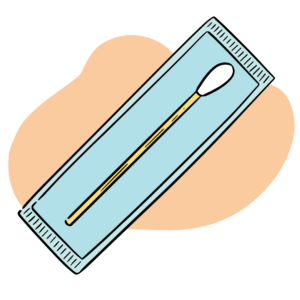 The only way to know for sure you have chlamydia is to get tested. You can keep an eye out for the signs and symptoms listed above, but remember, many chlamydia infections don’t cause any short term symptoms.
The only way to know for sure you have chlamydia is to get tested. You can keep an eye out for the signs and symptoms listed above, but remember, many chlamydia infections don’t cause any short term symptoms.
Chlamydia is tested for through the collection of genital, oral, and anal swabs and/or urine samples. These samples are then tested with NAAT tests. You can get tested for chlamydia at sexual health clinics, by requesting a test from your family doctor, or some walk-in clinics.
Can Chlamydia be treated?
Yes! Chlamydia can be treated with antibiotics that are highly effective at clearing the infection. The vast majority of people will make a full recovery after a single course of treatment (sometimes given as daily pills for 7 days or as a one time treatment). It is a good idea to wait 7 days after completing treatment before having sex to ensure the infection has cleared from your system.
Most places recommend that you retest for chlamydia 6 months after treatment to ensure the infection is gone.
What happens if Chlamydia is left untreated?
For folks with a uterus the long term risks of Chlamydia can be more severe. The bacteria can travel up the vagina into the cervix and uterus, and even the fallopian tubes. This is called pelvic inflammatory disease (PID). The symptoms of PID can include:
- Fever and chills
- Pain, aching and/or cramping in the abdomen, lower back, and during sex
- Unusual vaginal discharge, bleeding, or urination (peeing)
- PID can be quite painful and sometimes lead to infertility or make it more difficult to conceive.
For folks with (non-surgically constructed) penises the long term risks of Chlamydia are considerably less severe. Still, it can make you feel quite unwell before you treat it. And, untreated chlamydia can increase your likelihood of contracting other infections such as HIV.
You can learn more about where HEAL NS got this information from at: NovaScotia, ActionCanada, MayoClinic
*disclaimer: we do not necessarily endorse all of the information, content, or language used in these references
What is Gonorrhoea?
Gonorrhoea is a bacterial infection caused by the bacteria Neisseria gonorrhoeae. This bacteria can grow in the urethra (pee-hole), vagina, cervix, uterus, fallopian tubes, and in some cases the mouth and/or throat. This means that anyone, with any body parts, is susceptible to getting gonorrhoea.
In Nova Scotia, Gonorrhoea rates remain quite low, but it is still present. Most recent data, from 2020 shows that 9 out of 100,000 Nova Scotians had Gonorrhea. While this makes it a lower risk STI for sexually active Nova Scotians, it is still important to know about and prevent because complications of this infection can be quite serious.
What are the long term effects of Gonorrhea?
If Gonorrhea is left untreated, it can lead to some fairly serious health conditions. These conditions and risks vary depending on what body parts you have. In some cases, it can even develop into a life-threatening condition.
For people with uteruses and/or cervixes: The most common long-term risk of untreated gonorrhoea is Pelvic Inflammatory Disease (PID). The symptoms of PID can include:
- Fever and chills
- Pain, aching and/or cramping in the abdomen, lower back, and during sex
- Unusual vaginal discharge, bleeding, or urination (peeing)
 PID can be quite painful and sometimes lead to infertility or make it more difficult to conceive.
PID can be quite painful and sometimes lead to infertility or make it more difficult to conceive.
In folks with testicles, untreated chlamydia can lead to epididymitis, where the testicles become swollen and painful. Epididymitis, in rare cases, can lead to infertility.
For all bodies, rare cases of untreated gonorrhoea can lead to disseminated gonococcal infection (DGI), a painful condition that can be life threatening. This condition occurs when the infection spreads to other parts of the body through the bloodstream. It can lead to a number of conditions including:
- Septic arthritis (infection in the joints that can lead to long-term joint damage)
- Skin lesions
- Endocarditis (inflammation of the heart)
- Meningitis (inflammation of the tissue around the brain and spinal cord).
How can I prevent transmitting Gonorrhea?
Gonorrhoea is spread through sexual contact with someone who has a gonorrhoea infection. This includes any contact with mouths or genitals. It can also be passed on to babies during pregnancy, childbirth or breast/chest – feeding.
The three, most important steps in preventing the spread of gonorrhoea is using barrier protection, getting tested, and talking to your partners about risk. Protection creates a barrier that prevents the passing of fluids from one person to another, which stops the bacteria from passing as well. You can learn more about what protection options are available to you, and how to use them, in our ‘Barrier Protection and Contraception’ section. If someone has an infection in their throat or mouth, gonorrhoea can still be spread through kissing which is why testing is so important, even for folks who use protection consistently and correctly.
How can I get tested for Gonorrhea?
 In Nova Scotia, the most commonly used test where a sample is collected by swabing your genitals, anus, and/or throat or a urine sample. People can test reliably 48 hours after exposure using this test. This means that the test will be accurate as long as you didn’t get the infection within 48 hours of when you took the test.
In Nova Scotia, the most commonly used test where a sample is collected by swabing your genitals, anus, and/or throat or a urine sample. People can test reliably 48 hours after exposure using this test. This means that the test will be accurate as long as you didn’t get the infection within 48 hours of when you took the test.
It is a great idea to test regularly for Gonorrhea as a part of your sexual health testing routine. You can at most places that do other STI tests, check out our where to get tested page, or SugarHealth to find out where to get tested near you.
Can Gonorrhoea be treated?
 Yes! Gonorrhoea can be treated with antibiotics. Generally in Nova Scotia you will be prescribed a combination of antibiotics to be taken at the same time, this is because some strains of gonorrhoea can be resistant to a certain type of bacteria, and so treating with a combination antibiotic is more likely to be effective right away. Typically, antibiotics are prescribed for 2 weeks, although this may vary and you must always follow the instructions given to you from your doctor.
Yes! Gonorrhoea can be treated with antibiotics. Generally in Nova Scotia you will be prescribed a combination of antibiotics to be taken at the same time, this is because some strains of gonorrhoea can be resistant to a certain type of bacteria, and so treating with a combination antibiotic is more likely to be effective right away. Typically, antibiotics are prescribed for 2 weeks, although this may vary and you must always follow the instructions given to you from your doctor.
You can learn more about where HEAL NS got this information from at: CANADA, CDC, CDC
*disclaimer: we do not necessarily endorse all of the information, content, or language used in these references.
What is Syphilis?
 Syphilis is an STI caused by the bacterium Treponema pallidum. Syphilis is transmitted through blood, including the blood of an open sore caused by the infection. It is most commonly passed from one person to another during penetrative sex, oral sex, sharing sex toys, and sometimes through pregnancy and/or childbirth. Aside from the severe health outcomes that can occur when someone has untreated syphilis, part of what makes it so dangerous is that its symptoms are easily confused for other illnesses. This means that lots of people won’t realise they got syphilis even if they are showing symptoms.
Syphilis is an STI caused by the bacterium Treponema pallidum. Syphilis is transmitted through blood, including the blood of an open sore caused by the infection. It is most commonly passed from one person to another during penetrative sex, oral sex, sharing sex toys, and sometimes through pregnancy and/or childbirth. Aside from the severe health outcomes that can occur when someone has untreated syphilis, part of what makes it so dangerous is that its symptoms are easily confused for other illnesses. This means that lots of people won’t realise they got syphilis even if they are showing symptoms.
Syphilis infections are understood in three stages: primary syphilis, secondary syphilis, latent syphilis, and tertiary syphilis.
 Primary syphilis occurs right after infection enters the body and as it establishes itself. This stage is marked by the presence of an often painless hard round sore that appears on the spot where the bacteria entered the body – this sore is called a chancre. The chancre typically lasts 3 – 6 weeks regardless of if a person receives treatment. Since it is painless, it can often go unnoticed in places like your anus, vagina, or throat. It can be accompanied by other sores around it.
Primary syphilis occurs right after infection enters the body and as it establishes itself. This stage is marked by the presence of an often painless hard round sore that appears on the spot where the bacteria entered the body – this sore is called a chancre. The chancre typically lasts 3 – 6 weeks regardless of if a person receives treatment. Since it is painless, it can often go unnoticed in places like your anus, vagina, or throat. It can be accompanied by other sores around it.
 Secondary syphilis is marked by the onset of skin lesions and rashes. This can happen before, or weeks after, the chancre heals. They can appear on many areas of the body and are sometimes (but not always itchy). Some folks also get white raised sores known as Condyloma lata that are most commonly found in moist areas (like the genitals or under-arms), Lots of other symptoms can accompany this stage like fever, fatigue, hair loss, muscle aches, and sore throats.
Secondary syphilis is marked by the onset of skin lesions and rashes. This can happen before, or weeks after, the chancre heals. They can appear on many areas of the body and are sometimes (but not always itchy). Some folks also get white raised sores known as Condyloma lata that are most commonly found in moist areas (like the genitals or under-arms), Lots of other symptoms can accompany this stage like fever, fatigue, hair loss, muscle aches, and sore throats.
Latent stage syphilis is often known as the silent stage of a syphilis infection. This is because the infection shows no symptoms during this period. Latent stage syphilis can last for many many years.
Not everyone who has latent stage syphilis will reach the tertiary stage of this infection, but for those who do it can be fatal. Syphilis can infect most major organs, and the symptoms of tertiary syphilis vary greatly depending on the affected organ.
How can I prevent transmitting Syphilis?
As with many STIs, the three main things you should do to lower your risk of getting or passing along STIs is to 1) use barrier protection, 2) getting tested, and 3) communicating with your sex partners.
Using barrier protection for penetrative sex, oral sex, and with sex toys is a super important way to reduce the risk of transmitting syphilis. Check out our barrier protection and contraception section to learn more.
As discussed in the last section, the long term effects of syphilis can be quite severe. Getting tested regularly allows you to treat the infection before it moves on to a more dangerous phase. BUT it also helps you avoid giving it to other people. Getting tested means that you can be more confident that you aren’t passing this STI on to sexual partners, and it means that if you do get syphilis you can pause the things you do that might pass the infection on to others until you are finished treating it. Check out the section below to learn more about where/how to get tested in Nova Scotia.
Lastly, talking to the people you are having sex with is a super important way to avoid getting syphilis. It can feel awkward to bring up, but having conversations about what preventative methods you both want to use, and what your risk is is a super important part of keeping everyone safe. You can start by offering up your own info – when were you last tested? What do you like to do to avoid getting STIs? And then encourage them to share too. This conversation also can make the experience of sex more comfortable, and less wrapped up in anxiety around the likelihood of contracting or passing along an STI.
How do I know if I have/get Syphilis?
While it is always great to keep an eye out for symptoms that might point to this infection, the only way to be confident in whether or not you have syphilis is to get tested.
 In Nova Scotia, Syphilis testing is done through a blood sample. A health practitioner will give you a requisition to get blood taken, and this sample will be sent off to a lab to be tested. Sometimes, in the case of a positive result, a second sample will be asked for to confirm you have an active syphilis infection.
In Nova Scotia, Syphilis testing is done through a blood sample. A health practitioner will give you a requisition to get blood taken, and this sample will be sent off to a lab to be tested. Sometimes, in the case of a positive result, a second sample will be asked for to confirm you have an active syphilis infection.
So, when do you get tested? It is a good idea to make syphilis testing a part of your STI testing routine. You can check out our checklist to learn more. If you had a recent exposure, or are worried you might have syphilis, the testing available in Nova Scotia often can’t detect the infection until 3-4 weeks after transmission. If you get tested and it comes back negative, it is a good idea to test again in 4 weeks to reduce your chances of getting a false negative.
You can get testing at your local sexual health center, from a family doctor, and from the infectious disease clinic in Halifax. If you are a student many universities and some high schools will have health clinics where you can get tested. Additionally, some walk-in clinics will offer STI testing, but it is a good idea to call ahead of time to confirm a specific walk-in clinic can offer that service. You can check out Sugar Health to find the testing site closest to you.
Can Syphilis be treated?
 Yes, Syphilis can be treated! In Nova Scotia it is generally treated with either antibiotics or a Penicillin injection. It is important to continue to take this medication until the infection clears, and so it’s a good idea to discuss follow up, medication schedules, and future testing with your doctor as soon as you find out you have syphilis.
Yes, Syphilis can be treated! In Nova Scotia it is generally treated with either antibiotics or a Penicillin injection. It is important to continue to take this medication until the infection clears, and so it’s a good idea to discuss follow up, medication schedules, and future testing with your doctor as soon as you find out you have syphilis.
It is important to note that you can still be contagious while you are on syphilis treatment. Do your best to not engage in any activities / behaviours that might risk passing the infection on to someone else until you have gotten confirmation from your doctor that the infection is gone.
It is possible to get syphilis again, and so we recommend continuing to manage your own risk and get tested regularly even if you have had syphilis before.
You can learn more about where HEAL NS got this information from at: CANADA, CDC, MayoClinic, CANADA, NovaScotia
*disclaimer: we do not necessarily endorse all of the information, content, or language used in these references.
What is Trichomoniasis?
Trichomoniasis, unlike most of the other STIs in this section, is not caused by a virus, but instead a tiny single-celled parasite that gets into the skin around the genitals. It is relatively rare in Nova Scotia, but still encouraged to test for.
Tricomoniasis can affect anyone with any body, but is more likely to cause symptoms in those with vaginas.
How can you prevent transmitting Trichomoniasis?
As with most STIs, there are things you can do to manage your risk when having sex, including barrier protection, open communication with partners, and a regular testing schedule.
Trichomoniasis is often asymptomatic (meaning no symptoms will indicate to you you might have it and so routine testing is recommended. Trichomoniasis tests are done through swab samples that can be taken at the same time as chlamydia and gonorrhoea tests.
What are the symptoms of Trichomoniasis?
Symptoms of Trichomoniasis include:
- Abnormal discharge (yellow-green in a vagina and thin white from a penis)
- Pain while peeing or during sex
- Discomfort, itching, or swelling
You can learn more about where HEAL NS got this information from at: HSHC, MayoClinic,
*disclaimer: we do not necessarily endorse all of the information, content, or language used in these references.
What is Herpes?
Herpes Simplex Virus (HSV, also referred to as just Herpes) is a common STI that can be transmitted through sexual contact as well as other forms of contact. There are two types of HSV: HSV-1 and HSV-2. HSV-1 is also often referred to as oral herpes as it most commonly appears in and around the mouth. It can also infect the genitals. HSV-2 is less common and only infects the genitals.
 For a number of reasons HSV cases are not reported to public health in the same way as most STIs, for this reason we do not have exact numbers on HSV cases in Canada or Nova Scotia. That being said, it is estimated that 90% of the population worldwide has HSV-1, and around 20% of the population worldwide has HSV-2. It is incredibly common, and while it can be painful and uncomfortable it is not dangerous.
For a number of reasons HSV cases are not reported to public health in the same way as most STIs, for this reason we do not have exact numbers on HSV cases in Canada or Nova Scotia. That being said, it is estimated that 90% of the population worldwide has HSV-1, and around 20% of the population worldwide has HSV-2. It is incredibly common, and while it can be painful and uncomfortable it is not dangerous.
 Both HSV-1 and -2 appear as small sores (with HSV-2 only appearing around the genitals). The sores can appear as small bumps, blisters, or open sores. They can be painful or uncomfortable, although they aren’t always. Oral herpes can sometimes be confused with canker sores, but are distinct in a few ways. HSV generally appears around the mouth whereas canker sores appear on the inner lip. Canker sores are not contagious.
Both HSV-1 and -2 appear as small sores (with HSV-2 only appearing around the genitals). The sores can appear as small bumps, blisters, or open sores. They can be painful or uncomfortable, although they aren’t always. Oral herpes can sometimes be confused with canker sores, but are distinct in a few ways. HSV generally appears around the mouth whereas canker sores appear on the inner lip. Canker sores are not contagious.
The first time someone develops HSV symptoms is often the worst, it can be more painful and sometimes be accompanied by fevers and fatigue. People with HSV can have episodes of symptoms and vastly varying frequencies and severities for the rest of their lives. Some people will never show symptoms again, and some may develop sores regularly. A number of factors can influence the development and severity of symptoms including stress, diet, and sleep.
Since HSV is so widespread, and because it is almost impossible to trace HSV transmission back to a single point of contact, Health Canada does not do any contact tracing with known HSV cases.
Herpes and Stigma
Herpes is one of the earliest recorded STIs, and in fact, was so common that it wasn’t considered an STI until the 60s when testing was developed to differentiate between HSV-1 and -2. In the 1970s, a pharmaceutical company developed a drug to treat the sores. They promoted this with an extensive and unprecedented ad campaign. Many people attribute the cultural idea that herpes is ‘gross’ to this campaign.
It is important to understand the risks associated with HSV, how you can treat it, and how you can avoid spreading it, but it is also important to know that first, it is very very rarely dangerous, and second, it is very common.
How can I prevent transmitting Herpes?
Both HSV-1 and -2 can be spread through close contact or exchanging of fluids. HSV-1 is more easily spread as it can be passed through sexual contact, or more casual forms of contact like kissing, or even sharing a drink. HSV-2 is most commonly passed through sexual contact involving genitals, although it can more rarely be passed through sharing unwashed towels, underwear, or bathing suits.
Both HSV-1 and -2 are much more likely to be passed when an active sore is present, while non-symptomatic transmission is possible, it is considerably less common.
It is also important to know that HSV can live in your body without showing symptoms for years, and sometimes even for someone’s entire lifetime. Sometimes, when people develop symptoms years into a monogamous relationship the assumption is that they have cheated, but the appearance of HSV symptoms or an HSV diagnosis does not mean that the virus was contracted any time recently.
In order to prevent passing along or getting HSV we recommend using barrier protection during sex, having open and honest conversations around HSV with sexual partners, and avoiding sexual activities if sores are present and until they have completely healed.
How do I know if I have/get Herpes?
 In Nova Scotia, HSV cannot be tested through blood tests, and can only be tested when an active sore is present. You can go to your doctor, the closest sexual health or testing clinic, and some walk-in clinics and ask the doctor to swab a sore that you have. They will then test this swab to see if HSV is present. If you have an open sore we encourage you to let the person you book your appointment with know as many clinics will have priority appointments or lists for people who are actively symptomatic.
In Nova Scotia, HSV cannot be tested through blood tests, and can only be tested when an active sore is present. You can go to your doctor, the closest sexual health or testing clinic, and some walk-in clinics and ask the doctor to swab a sore that you have. They will then test this swab to see if HSV is present. If you have an open sore we encourage you to let the person you book your appointment with know as many clinics will have priority appointments or lists for people who are actively symptomatic.
If a sexual partner of yours gets diagnosed with HSV you do not need to do anything unless you begin showing sores on/around your mouth and/or genitals. We recommend examining your genitals and throat with a mirror and keeping an eye out for symptoms of HSV. If they appear you should request an urgent appointment to get the sores tested.
Can Herpes be treated?
HSV can never be cured, but its symptoms can be managed. There are topical treatments that folks can get to put on sores when they appear. These treatments can help manage pain/discomfort and help them go away faster. Additionally, people can do things like wear loose fitting clothes and sit in warm baths (avoid bubbles or scented products) to help ease the pain when the sores appear.
For people who get sores a lot, and find that the frequency/severity of the symptoms causes a disruption in their lives there are antiviral medications that people can take daily. These medications help lessen these episodes.
If you are looking for more in depth information on HSV we recommend checking out this guide by the Halifax Sexual Health Centre.
You can learn more about where HEAL NS got this information from at: HSHC, WHO, MayoClinic, Hopkins Medicine, Canada, Herpes.org
*disclaimer: we do not necessarily endorse all of the information, content, or language used in these references.
Mpox (previously known as monkeypox) is a virus that spreads through close skin contact. It is related to the virus smallpox. Since it spreads through close skin contact, it is likely to spread through sexual contact if one partner has an active infection.
There are two types of mpox, Clade I and Clade II; Clade II is the type that most recently had an outbreak, and over 99.9% of folks who get it survive – although it can lead to serious illness. Common symptoms of mpox include:
- Fever and related symptoms
- Exhaustion
- Muscle pain and/or headache
- The appearance of a rash.
Note: the CDC website has some great photos of what this rash can look like
As of fall 2024 there has been another surge in mpox in Canada, at risk populations are recommended to get the vaccine if they have not already had 2 doses. If they have had a past dose the vaccine is still effective. That being said, it is good to know what symptoms to look out for. If you notice any of these symptoms on yourself or a partner refrain from close contact and get them checked out by a doctor.
You can learn more about the mpox vaccine in this section.
You can learn more about where HEAL NS got this information from at: NovaScotia, CDC, NovaScotia, Nova Scotia – DHW
*disclaimer: we do not necessarily endorse all of the information, content, or language used in these references.
Check out our full HIV section here.
What is pubic lice?
 Pubic lice, commonly referred to as crabs, is a type of louse that lives in coarser hair on the body. It is most commonly found in pubic hair (the hair around the genitals) although it can also be found in armpit hair, and infrequently in beards or eyelashes.
Pubic lice, commonly referred to as crabs, is a type of louse that lives in coarser hair on the body. It is most commonly found in pubic hair (the hair around the genitals) although it can also be found in armpit hair, and infrequently in beards or eyelashes.
These lice are small bugs which feed off of human blood and lay eggs along the shaft of pubic hair. They live for around 3-4 weeks, but can only survive 24-48 off of a human without feeding.
How do I know if I have/get pubic lice?
The only sure way to know if you have pubic lice is to find them. You can keep an eye out for symptoms such as itching in your pubic area, but we recommend checking yourself regularly if you are having sex with your genitals.
You can look for lice by running a lice comb through your pubic hair and wiping it on a damp white paper towel, tissue, or piece of toilet paper and examining the paper. They can be hard to spot, especially if they are young or male.
How can I prevent transmitting pubic lice?
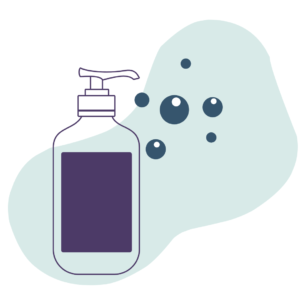 The best thing you can do is monitor yourself for pubic lice. If you do find them, immediately purchase over the counter pubic lice treatment and follow the instructions on the label. Do not use scalp lice treatment on your pubic hair.
The best thing you can do is monitor yourself for pubic lice. If you do find them, immediately purchase over the counter pubic lice treatment and follow the instructions on the label. Do not use scalp lice treatment on your pubic hair.
Shaving and most other forms of hair removal do not prevent or treat pubic lice. The lice are resilient and can cling to even very short stubs of hair or other hair on your body.
You can learn more about where HEAL NS got this information from at: PlannedParenthood, KidsHealth
*disclaimer: we do not necessarily endorse all of the information, content, or language used in these references.



